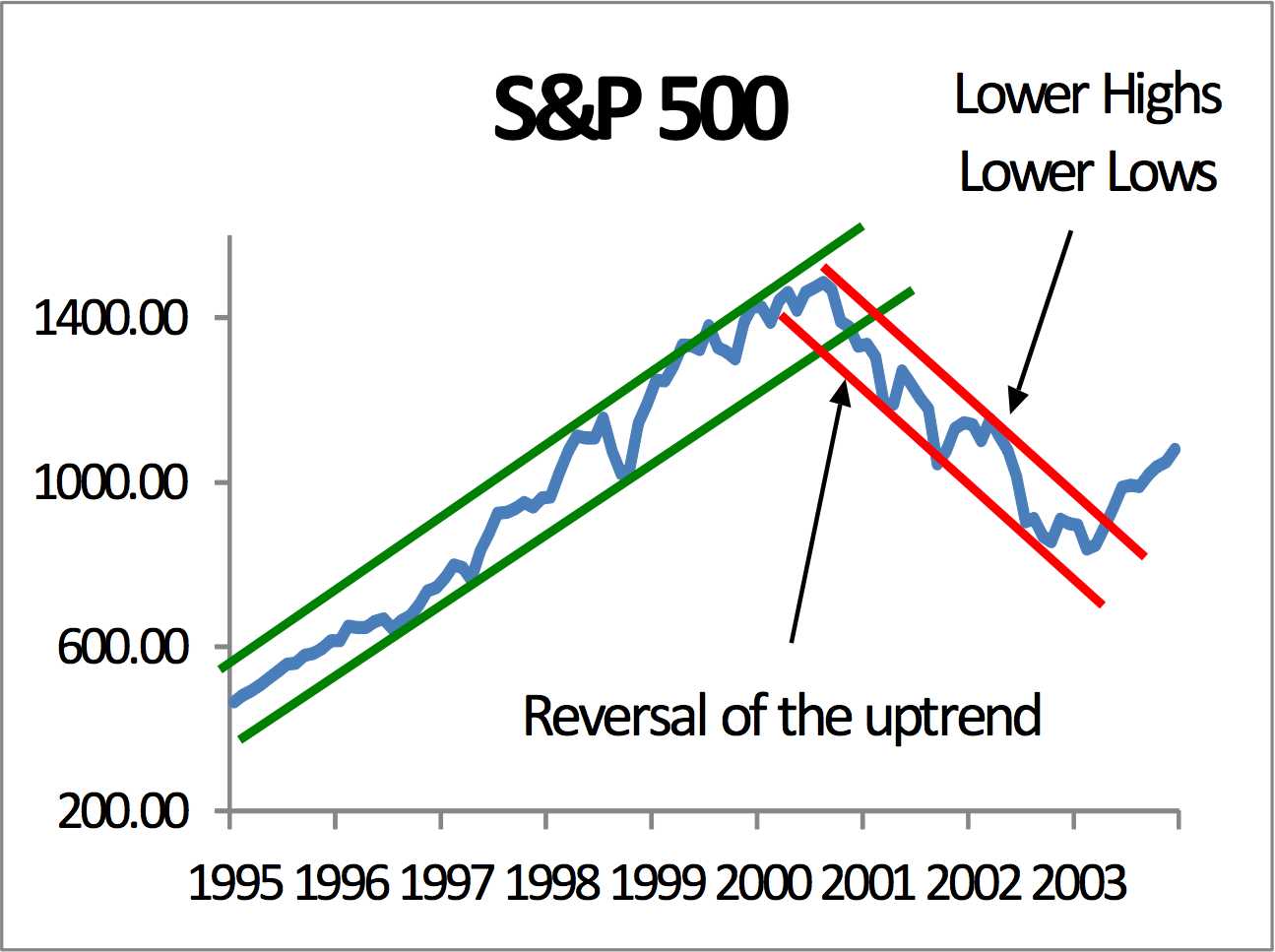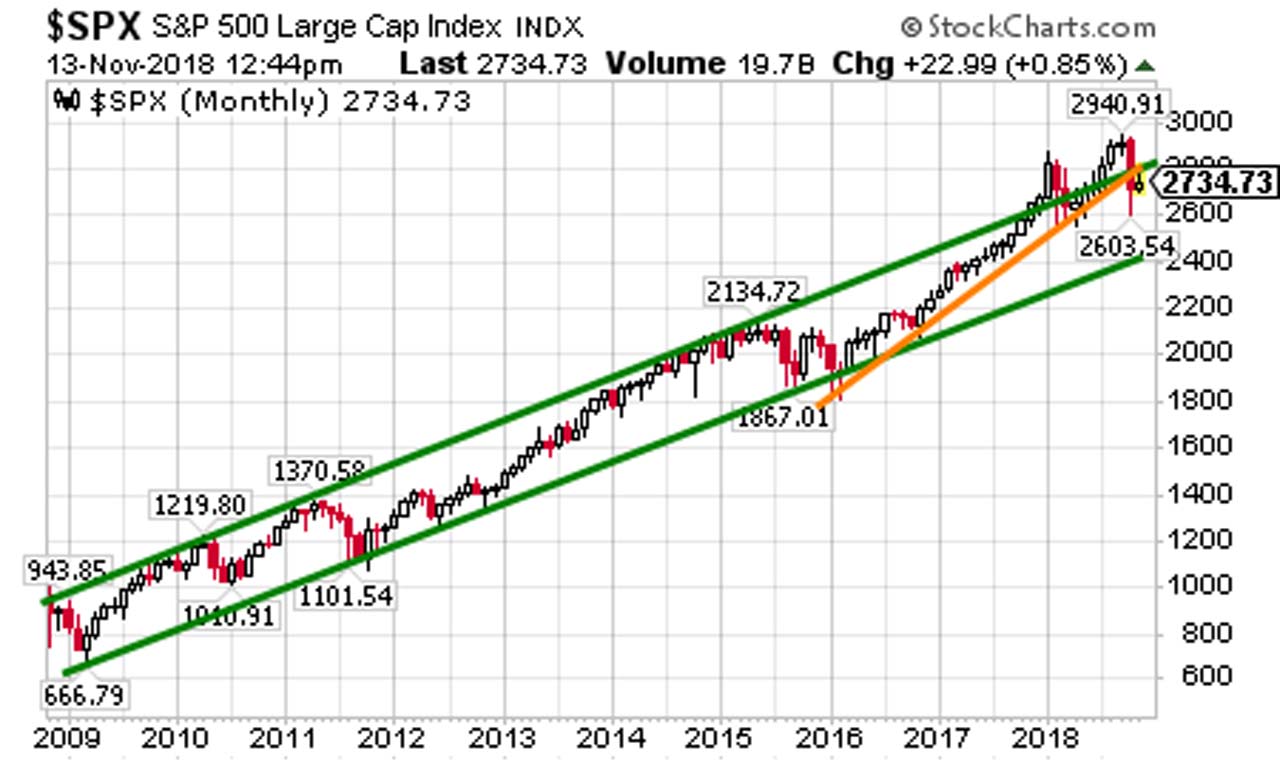A Better Way to Tell a Correction from a Bear Market?
You could go by the usual definition, but dive a little deeper into the market and you might get a better indication of what's going on before making any stock moves.


The standard definition of a correction is a 10% market decline, while a bear market is a 20% decline. These are simple definitions … I take a different view.
At Cornerstone, we view a correction as a significant decline within an up trend. The key here is that the up trend continues after the correction is over. Two examples are the crash in 1987 and the correction of 1990. In both cases, the market fell 20% or more, yet they recovered quickly and the up trend continued.
As you can see in the chart below, the up trend (green lines) continued upward, but the market, (blue line) vacillated between the two green up trend lines. Since the declines did not reverse the trend, they were only corrections, however, since they were declines of over 20%, by the standard definition, they were called bear markets.
From just $107.88 $24.99 for Kiplinger Personal Finance
Become a smarter, better informed investor. Subscribe from just $107.88 $24.99, plus get up to 4 Special Issues

Sign up for Kiplinger’s Free Newsletters
Profit and prosper with the best of expert advice on investing, taxes, retirement, personal finance and more - straight to your e-mail.
Profit and prosper with the best of expert advice - straight to your e-mail.

Why is that significant? Buying the dip has been a successful strategy for investors over the past nine years. Corrections can be a buying opportunity, since the market is still in an up trend. Current positions do not need to be sold, again since the market is still in an up trend.
At Cornerstone, we define a bear market as the reversal of an up trend. This can be seen in 2000 and 2007. A reversal of an up trend is usually characterized by a chart with lower lows and lower highs. Since the lows keep going lower, the chart reverses trend, and an up trend starts to head down (red lines).

For investors, what that means is with a bear market, rallies are to be sold, and dips are not bought. As you can see from the chart, buying the dips only leads to lower lows. Selling rallies is the wise move in a bear market.
Once a chart breaks above the down trend and the lows start getting higher and the highs start getting higher, the bear market is over and the market has reversed into a bull market.
Why do markets peak, and how far can a bear market go? Overvaluation makes markets fragile. So the more overvalued, the more vulnerable it is to a correction or a bear market. Historically, bear markets (as defined by Cornerstone) did not bottom until valuations were extremely low. The price-to-earnings ratio of the market has hit single digits in the past at bear market bottoms. Today’s Shiller P/E is over 30.
How can you tell if a correction is on its way to becoming a bear market? You don’t know until the chart tells you. If after a decline, the market fails to return to its up trend, that is a sign that a bear market has begun.
Where are we today? As you can see in the chart below, the market has not made lower lows, which means the first step in a bear market hasn’t happened yet. So, for now, the market is in a correction.

The green lines indicate the long-term up trend. The thin orange line indicates what some call the “Trump rally.” This refers to the market’s rise since President Trump was elected. On the Dow Jones, this Trump rally trend could be broken, and the market could drop a bit further, but it still has a ways to go before it even falls to the level of the top green line that marks the upper limits of the up trend. As long as it holds that trend line, and follows it up, the market would not have fallen into a bear.

The S&P chart above is a little different. The upper end of the up trend channel and the Trump rally are hitting the same spot right now. So a failure of one means the failure of the other. As you can see by the chart, the S&P is currently slightly below each trend line.
Does this mean it’s the start of a bear market? Not yet. The first indicator would be if the low fell below the previous low from the 1st quarter of 2018. And then the subsequent rally would have to fail to make new highs, at least above the upper trendline. Then time will tell.
Watching if the lows go lower and the highs go lower are good signs the market is rolling into a bear. And especially if the market drops below the lower green up trend line.
In the meantime, it’s only a correction within an up trend, and should be treated as such, by holding onto quality investments and adding investments that have become oversold. Will it turn into a bear market? Only time will tell, so we are watching things closely and have strategies — such as selling into rallies, reducing equity exposure, and raising cash among others — for various outcomes.
Third-party posts do not reflect the views of Cantella & Co Inc. or Cornerstone Investment Services, LLC. Any links to third-party sites are believed to be reliable but have not been independently reviewed by Cantella & Co. Inc. or Cornerstone Investment Services, LLC. Securities offered through Cantella & Co., Inc., Member FINRA/SIPC. Advisory Services offered through Cornerstone Investment Services, LLC's RIA.
Profit and prosper with the best of Kiplinger's advice on investing, taxes, retirement, personal finance and much more. Delivered daily. Enter your email in the box and click Sign Me Up.

In 1999, John Riley established Cornerstone Investment Services to offer investors an alternative to Wall Street. He is unique among financial advisers for having passed the Series 86 and 87 exams to become a registered Research Analyst. Since breaking free of the crowd, John has been able to manage clients' money in a way that prepares them for the trends he sees in the markets and the surprises Wall Street misses.
-
 Nasdaq Leads as Tech Stages Late-Week Comeback: Stock Market Today
Nasdaq Leads as Tech Stages Late-Week Comeback: Stock Market TodayOracle stock boosted the tech sector on Friday after the company became co-owner of TikTok's U.S. operations.
-
 Disney’s Risky Acceptance of AI Videos
Disney’s Risky Acceptance of AI VideosThe Kiplinger Letter Disney will let fans run wild with AI-generated videos of its top characters. The move highlights the uneasy partnership between AI companies and Hollywood.
-
 Ask the Editor: Itemized Deductions
Ask the Editor: Itemized DeductionsAsk the Editor In this week's Ask the Editor Q&A, Joy Taylor answers questions on itemized deductions claimed on Schedule A of Form 1040
-
 Are You Putting Yourself Last? The Cost Could Be Your Retirement Security
Are You Putting Yourself Last? The Cost Could Be Your Retirement SecurityIf you're part of the sandwich generation, it's critical that you don't let the needs of your aging parents come at the expense of your future.
-
 I'm an Insurance Pro: It's Time to Prepare for Natural Disasters Like They Could Happen to You
I'm an Insurance Pro: It's Time to Prepare for Natural Disasters Like They Could Happen to YouYou can no longer have the mindset that "that won't happen here." Because it absolutely could. As we head into 2026, consider making a disaster plan.
-
 The Future of Philanthropy Is Female: How Women Will Lead a New Era in Charitable Giving
The Future of Philanthropy Is Female: How Women Will Lead a New Era in Charitable GivingWomen will soon be in charge of trillions in charitable capital, through divorce, inheritance and their own investments. Here's how to use your share for good.
-
 5 Smart Things to Do With Your Year-End Bonus, From a Financial Professional
5 Smart Things to Do With Your Year-End Bonus, From a Financial ProfessionalAfter you indulge your urge to splurge on a treat, consider doing adult things with the extra cash, like paying down debt, but also setting up a "fun fund."
-
 Are You a Gen X Investor? Here's How You Can Protect Your Portfolio From an AI Bubble
Are You a Gen X Investor? Here's How You Can Protect Your Portfolio From an AI BubbleAmid talk of an AI bubble, what's the best course of action for investors in their 50s and 60s, whose retirement savings are at risk from major market declines?
-
 Hey, Retirees: Put Your Charitable Gifts in a Donor-Advised Fund (and Enjoy Your Tax Break)
Hey, Retirees: Put Your Charitable Gifts in a Donor-Advised Fund (and Enjoy Your Tax Break)A donor-advised fund is a simple (really!), tax-smart strategy that lets you contribute a large, tax-deductible gift now and then distribute grants over time.
-
 If You're a U.S. Retiree Living in Portugal, Your Tax Plan Needs a Post-NHR Strategy ASAP
If You're a U.S. Retiree Living in Portugal, Your Tax Plan Needs a Post-NHR Strategy ASAPWhen your 10-year Non-Habitual Resident tax break ends, you could see your tax rate soar. Take steps to plan for this change well before the NHR window closes.
-
 Your Year-End Tax and Estate Planning Review Just Got Urgent
Your Year-End Tax and Estate Planning Review Just Got UrgentChanging tax rules and falling interest rates mean financial planning is more important than ever as 2025 ends. There's still time to make these five key moves.